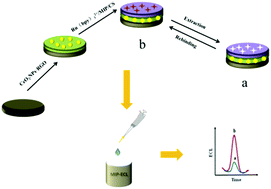A novel MIP-ECL sensor based on RGO–CeO2NP/Ru(bpy)32+-chitosan for ultratrace determination of trimipramine†
Abstract
A novel molecularly imprinted polymer (MIP)-electrochemiluminescence (MIP-ECL) sensor based on CeO2NP–RGO/Ru(bpy)32+–MIP–chitosan was introduced for the ultrasensitive and ultraselective detection of trimipramine (TRI). TRI-MIP was synthesized via the precipitation polymerization process. A nanocomposite of reduced graphene oxide decorated with ceria (CeO2NP–RGO) was synthesized through a facile sonochemical process. CeO2NP–RGO was utilized for modifying the surface of an electrode which consequently led to an excellent electrical conductivity, enhanced electrochemical and ECL characteristics of Ru(bpy)32+. Electrochemical and ECL behaviors of the MIP-ECL sensor were evaluated. Accordingly, the ECL intensity was significantly enhanced via TRI molecule adsorption on the MIP composite film. The prepared MIP-ECL sensor demonstrated high sensitivity and selectivity as well as good reproducibility and stability for TRI determination under the applied optimal conditions. The assays response for TRI concentration was linear in the range of 0.2–100 pM with a 0.995 correlation coefficient. The limit of detection (LOD) was as small as 0.025 pM (S/N = 3). The recoveries between 91–107% for human serum (RSDs < 4.1%) and 94–104.6% for human urine (RSDs < 3.4%) approve that the MIP-ECL sensor can be used for precise detection of TRI in complex biological matrices. Ultimately, this sensor was utilized successfully for the analysis of TRI in human serum and urine samples without any special pretreatment.



 Please wait while we load your content...
Please wait while we load your content...